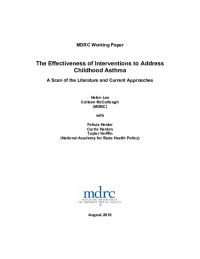The Effectiveness of Interventions to Address Childhood Asthma
A Scan of the Literature and Current Approaches

Asthma is the leading chronic health condition among children in the United States and a major cause of childhood disability. It also disproportionately affects low-income and racial and ethnic minorities. Although a wide range of interventions have been implemented to improve asthma-related outcomes among socioeconomically disadvantaged and minority children, disparities persist.
This paper, which was commissioned by the JPB Foundation and conducted by MDRC in partnership with the National Academy for State Health Policy, standardizes and compares effects from rigorous evaluations across three main types of interventions: those that focus on improving education and self-management, those that focus on addressing remediation of the conditions that trigger asthma in the home environment, and those that focus on improving health care provider practice. While prior reviews have summarized findings for each intervention type, this review systematically compares findings across a range of outcomes and a spectrum of different approaches to addressing childhood asthma, drawing from about 30 independent studies and earlier published reviews. In addition, the paper includes case studies of various local programs and state-level policy initiatives to illuminate current efforts to address childhood asthma in low-income communities and barriers faced in sustaining asthma programs.
Key Findings
-
Providing education on how to manage asthma is fundamental to improving outcomes, but it may not be enough to alleviate disparities in asthma management.
-
Some local programs are clearly bridging informational gaps among low-income families and are helping them maintain a safe home environment for their children with asthma. Some programs have adapted their services so they can tackle conditions and systems that are beyond the family’s control and that are often endemic to living in old and deteriorating housing.
-
However, the health care benefits of interventions that go beyond education are unclear. There is limited evidence demonstrating that these more intensive and costly programs are more effective at reducing urgent and serious health care encounters than are less expensive approaches.
-
Barriers to medication management are complex and medication adherence is difficult to influence. The steps needed to keep inflammation under control can be complicated and can change over time. Future evaluations should consider the importance of measuring and monitoring asthma management behaviors as an outcome of interest.
-
The role of the state, and the Medicaid program in particular, is relevant for the financing and sustainability of asthma programs for low-income children. Programs must be able to demonstrate a short-term positive return on investment before they can be replicated. However, the vast majority of published studies do not report information on cost savings or cost-effectiveness.
Although the long-run sustainability of some of the programs highlighted in this report is uncertain, what is clear is that combating the disparities in the prevalence of asthma among different populations will require more than an agreement on standard asthma management practices within the medical community.






